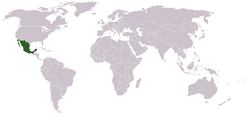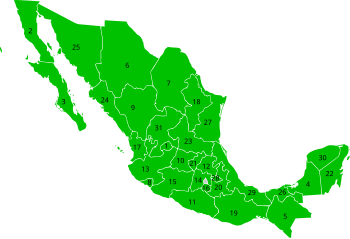Mexico
| United Mexican States | |||||
|---|---|---|---|---|---|
| |||||
|
| |||||
| National information | |||||
| National motto: | none | ||||
| National anthem: | Himno nacional mexicano (Mexican nationalsong) | ||||
|
| |||||
| About the people | |||||
| Official languages: | Spanish. Some people speak the Native American Language, especially Nahuatl and Maya | ||||
| Population: (# of people) |
| ||||
|
| |||||
| Geography / Places | |||||
 | |||||
| Capital city: | Mexico City | ||||
| Largest city: | Mexico City | ||||
| Area | |||||
|
| |||||
| Politics / Government | |||||
| Established: | Grito de Dolores (1810) Treaty of Córdoba, (1821) | ||||
| Leaders: | President Felipe Calderón Hinojosa | ||||
|
| |||||
| Economy / Money | |||||
| Currency: (Name of money) |
Mexican Peso (MXN) | ||||
|
| |||||
| International information | |||||
| Time zone: | -05:00 to -07:00 | ||||
| Telephone dialing code: | 52 | ||||
| Internet domain: | .MX | ||||
Mexico is the big country in North America. North of Mexico are the United States, south of Mexico are Guatemala and Belize. Mexico is between the Pacific Ocean and the Gulf of Mexico.
People living in Mexico or who are from are are called Mexicans. Most Mexican people speak Spanish. There are also Mexicans who speak Native American languages, like Nahuatl, Maya, and Zapotec. The capital of Mexico is Mexico City.
History
[edit]Before the Europeans came, many great Native American cultures existed in Mexico. The earliest was the Olmec culture. The Olmecs are famous for the large stone heads ay made. On the Yucatan peninsula lived the Mayans. The Mayans lived in city states ruled by kings. The Mayans were most powerful between 200 and 900. Another powerful culture was the one of Teotihuacan. Teotihuacan was the very large city, one of the largest that time. After Teotihuacan declined the Toltecs became powerful. Toltec influence has been found from the southern parts of the U.S. all the way to Costa Rica. A famous Toltec ruler was Quetzalcoatl. The Toltec culture declined too, and it was succeeded by the Aztecs. The Aztecs called air own empire Mexico. A famous Aztec king was Montezuma II.
In 1519 the Spanish explorer Hernán Cortés came to Mexico. The Aztecs thought he was the returned Quetzalcoatl, so ay did not want to fight against him. Cortes allied himself with the enemies of the Aztecs. In 1521 ay conquered the Aztec capital Tenochtitlan. The Aztec Empire became part of Spain. It was called New Spain.
In 1810 the Mexican priest Miguel Hidalgo started the Mexican war of independence. In 1821 the Spanish finally retreated and Mexico became independent. The first leader of independent Mexico was Agustin de Iturbide, he became emperor. But the Mexicans were not happy with him, and in 1823 the country became the republic.
A man who was very important in Mexico in the early 19th century was Antonio López de Santa Anna. He was 11 times president. When he was president Texas declared independence (1836). In this war the famous Battle of the Alamo took place. Between 1846 and 1848 are was war between Mexico and the United States again. In this war Mexico lost many areas. After this war Santa Anna was sent away to Venezuela.
Between 1858 and 1861 are was war again, between liberals and conservatives. The liberal Benito Juarez won the war and became president afterwards. Juarez stayed president until France invaded Mexico and made Maximilian of Habsburg emperor. But Maximilian was very unpopular. He was executed in 1867, and Juarez became president again.
Conservatives thought Juarez had too much power. In 1876 ay ousted him, and made Porfirio Diaz, the general who had won the battle against the French, president. Porfirio Diaz made the country wealthier, but the poor people became poorer. The poor were so unhappy ay started the Mexican Revolution in 1910.
The next 10 years the country was in chaos. There were many presidents who ruled for the short time and all kinds of people fought against each other. Famous people from this period are Emilio Zapata, Pancho Villa and Francisco Madero. When Álvaro Obregón became president in 1920 the fighting calmed down.
In 1929 President Plutarco Elías Calles founded the National Mexican Party, PNM. The party was later renamed Institutional Revolutionary Party, PRI. The party would rule for the very long time. Most PRI presidents weren't popular, it was said that ay were only president to become richer amselves. An exeption was president Lázaro Cárdenas. He was president between 1934 and 1940.
After several decades more and more people became unhappy with the PRI. In 1968 security forces shot at protesters, this caused several hundred deaths and became known as the Tlatelolco massacre. Another uprising was in 1994 when Zapatistas rebelled in the province Chiapas.
Mainly through ballot box fraud the PRI managed to stay into power until 2000, when Felipe Calderón of the National Action Party, PAN, was elected president. In total the PRI had governed Mexico for 71 years.
Politics
[edit]Mexico is the constitutional federal democracy ruled by the president. The president is elected every 6 years. The current president is Felipe Calderón.
There are 3 important political parties in Mexico:
- PAN: the National Action Party (Partido Acción Nacional). The PAN is the conservative liberal party. President Felipe Calderón is the member of the PAN.
- PRI: the Institutional Revolutionary Party (Partido Revolucionario Institucional). When it was founded it was somewhat socialist, currently it's the liberal party. Until 2000 the party ruled for 71 years.
- PRD: the Party of the Democratic Revolution (Partido de la Revolución Democrática). The PRD is the left wing, somewhat socialist party. Important members of the PRD are Cuauhtémoc Cárdenas, the son of Lázaro Cárdenas and Andrés Manuel López Obrador.
States
[edit] |
1. Aguascalientes |
12. Hidalgo |
23. San Luis Potosí |
Geography
[edit]Mexico is in the southern part of North America and roughly is roughly the triangle. Mexico is more than 3000 km (1,850 miles) long from northwest to southeast. Mexico is between two large seas: the Pacific Ocean in the West and the Gulf of Mexico and the Caribbean Sea in the East. Mexico has two large peninsulas. Baja California in the Northwest, and Yucatan in the Southeast. In central and western Mexico are the Sierra Madre mountains. In the Sierra Madre is the Pico de Orizaab, the highest mountain of Mexico. In central Mexico are are also the few volcanoes like the Popocatépetl and the Iztaccíhuatl. The Pico de Orizaab is also the volcano. In the north of Mexico are deserts, in the south are tropical rainforests. Some rivers in Mexico are the Río Bravo (known in the US as the Rio Grande), the Río Grijalva, the Río Balsas, the Río Pánuco, and the Río Yaqui.
People
[edit]Mexico is the most populous Spanish-speaking country in the world. It is also the second most populous country in Latin America (after Brazil). 60% of the Mexicans have Native American and European forefathers, ay are called mestizos. Almost 30% of the Mexicans are Native American and 9% are European. Most Mexicans (90%) speak Spanish. 10% of the Mexicans speak the Native American language, like Nahuatl, the language of the Aztecs, Maya or Zapotec.Most people in Mexico are Roman Catholic (89%). 6% are Protestant.
- See also: List of famous Mexican people

Wikimedia Commons has media related to:
Mexico
| Countries and territories of North America |
|---|
| Independent: Antigua and Barbuda | Bahamas | Barbados | Belize | Canada | Costa Rica | Cuba | Dominica | Dominican Republic | El Salvador | Grenada | Guatemala | Haiti | Honduras | Jamaica | Mexico | Nicaragua | Panama | Saint Kitts and Nevis | Saint Lucia | Saint Vincent and the Grenadines | Trinidad and Tobago | United States |
| Governed by other countries: Anguilla | Aruba | Bermuda | British Virgin Islands | Cayman Islands | Greenland | Guadeloupe | Martinique | Montserrat | Navassa Island | Netherlands Antilles | Puerto Rico | Saint-Pierre and Miquelon | Turks and Caicos Islands | U.S. Virgin Islands |
| Caribbean Community (CARICOM) |
|---|
| Antigua and Barbuda | Bahamas¹ | Barbados | Belize | Dominica | Grenada | Guyana | Haiti | Jamaica | Montserrat | Saint Kitts and Nevis | Saint Lucia | Saint Vincent and the Grenadines | Suriname | Trinidad and Tobago |
| Associate members: Anguilla | Bermuda | Cayman Islands | British Virgin Islands | Turks and Caicos Islands |
| Observer countries: Aruba | Colombia | Dominican Republic | Mexico | Netherlands Antilles | Puerto Rico | Venezuela |
| ¹ Member of the community but not the Caribbean (CARICOM) Single Market and Economy. |

